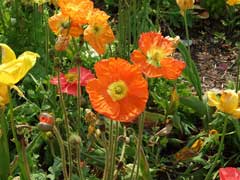
Arctic Poppy, Icelandic poppy
Latin Name: Papaver nudicaule
USDA Hardiness: 4-10
Native Range: TEMPERATE ASIA: Russian Federation-Eastern Siberia (Eastern Siberia), Russian Federation (Altay), Kazakhstan (southeast), Mongolia NORTHERN AMERICA: Canada (Yukon), United States (Alaska)
Edibility Rating: 1 / 5
Medicinal Rating: 1 / 5
Region:
Family:
Plant Type:
Medicinal Uses
Edible Uses
Edible Parts: Leaves Seed | Edible Uses: Leaves - cooked[2]. Very agreeable to the taste, the leaves are a good source of vitamin C[2]. Some caution is advised, see the notes above on toxicity. Seed - raw or cooked. Oleaginous and antiscorbutic, the seed is very agreeable to the taste[2]. It contains some opium[61]. Caution is advised, see note at top of page.
Cultivation
Landscape Uses:Alpine garden, Container, Foundation, Massing, Rock garden. Prefers a well-drained sandy loam in a sunny position[111, 200]. Prefers a fertile soil[200]. Prefers a deep soil that is poor and dry rather than rich, and strongly dislikes wet conditions[233]. Succeeds in dry soils. Prefers partial shade[188]. There are many named varieties selected for their ornamental value[200]. Members of this genus are rarely if ever troubled by browsing deer or rabbits[233]. A short-lived perennial, it is often grown as an annual or biennial[200]. It often dies out in heavy soils or wet winters[111]. Special Features: Attractive foliage, North American native, Naturalizing, All or parts of this plant are poisonous, Suitable for cut flowers, Fragrant flowers.
Known Hazards
This plant is toxic to mammals, though the toxicity is low[76].
Habitats
Stony slopes, river gravels and sandy meadows[74]. Dry, exposed, rocky openings such as on steep slopes, screes, and outcrops at elevations of 300 - 1000 metres in Alaska[270].
